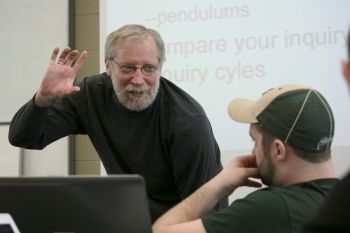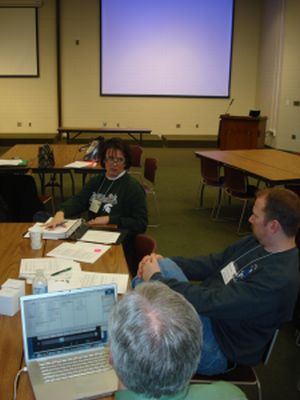By Nicole Geary
Students may have a better chance to save the planet in the future if they are taught less in science class today.
That’s because many science educators believe the curriculum in the United States attempts to cover too many topics without tying them together.
Kids jump from a unit on weather to one on simple machines. They learn ambitious collections of facts in separate required silos; biology, chemistry, physics.
But you don’t need to recite Newton’s Laws to be an excellent truck driver or baseball player. And the life cycle of stars won’t help us understand how our everyday actions affect ecosystems.

Charles "Andy" Anderson
“Students are not getting the big ideas they need to be scientifically literate citizens,” said Amelia Wenk Gotwals, an assistant professor of teacher education in the Michigan State University College of Education.
She and other faculty members at MSU are working to improve science education by zooming in on the scientific concepts all students really need to know, and determining how to grow understanding from one year to the next.
Led by veteran ground-breaker Charles “Andy” W. Anderson, their research on learning progressions – a new way to refine curriculum goals – has begun to shape the national dialogue during a critical turning point for science education.
The National Research Council created a committee that is developing a conceptual framework for new K-12 science standards.
Leaders agree the curriculum must change. The work of real scientists has become much more interdisciplinary in the last 20 years and yet many teachers still don’t have resources to effectively make connections across science content areas.
While scholars debate how to break down the status quo, Anderson takes a strong stand as an advocate for reconceptualizing science standards around environmental literacy.
For more than 10 years, he has been studying how children learn about things like air, soil and trees and their resulting confusion about concepts that literally explain how the world works, from molecules to the laws of matter and energy.
He helps run a large-scale effort to improve science teaching in Michigan’s rural school districts (and across the country) by engaging teachers in environmental science and education research. In the fall of 2008, he became co-principal investigator of a $12.5 million grant from the National Science Foundation to create a culturally relevant framework (or learning progression) where environmental literacy drives students’ learning of core science and mathematics concepts.
And that is only one in a series of related research grants for Anderson, a sort of conscientious rebel in his field, serious about securing our planet’s future by creating informed citizens in today’s classrooms.
President Barack Obama included support for environmental literacy in a new Department of Education program, identifying it among “the subjects important to a complete curriculum” with history, arts, financial literacy and foreign language.
“Traditional science education can no longer regard environmental science as peripheral,” Anderson said. “We have been unable to mount the political will to take collective action on environmental issues. The problem is that many people simply don’t understand the consequences of their actions on a scientific level.”
Getting to the core… for life on earth
Anderson, a professor in the College of Education since 1979, wasn’t always so focused on integrating environmental literacy into contemporary curriculum.
 Among the first researchers to study conceptual change theory, his thinking about effective science teaching – and preparing effective teachers – had already been on the cutting edge for more than 20 years when, in 2000, the American Association for the Advancement of Science (AAAS) asked him to help organize a conference.
Among the first researchers to study conceptual change theory, his thinking about effective science teaching – and preparing effective teachers – had already been on the cutting edge for more than 20 years when, in 2000, the American Association for the Advancement of Science (AAAS) asked him to help organize a conference.
The topic: What would it take to develop a complete package of research-based curriculum materials for K-12 science? His conclusion: Impossible.
“There are too many benchmarks that we are supposed to cover,” said Anderson, who decided there must be a better, coherent way to condense the objectives. “I asked the question: What is it everyone needs to understand or our nation suffers?
“And that is what led me to environmental science.”
Nearly everyone, at least since the 1990s, will say they value protecting the environment. But they often know very little about how to do that.
For example, when you ask kids how to improve water quality in their town, the most common answer is ‘don’t litter.’ Most adults believe planting trees is good for the environment because it reduces pollution, which is true but very vague.
“You need a scientific understanding of what the trees do with carbon dioxide before you can really understand when and how planting trees might help with an issue like climate change,” said Anderson, who was invited to serve on the national Climate Change Education Roundtable.
Children especially tend to adopt a “force-dynamic” view of the world in which plants and animals take actions (like growing) with access to the right enablers (such as soil, rain and sunlight).
 “They must think of a tree as not just an actor, but as a system that’s part of a larger global system. It’s moving carbon from the atmosphere into biomass, one of millions and millions of trees doing the same thing,” Anderson said.
“They must think of a tree as not just an actor, but as a system that’s part of a larger global system. It’s moving carbon from the atmosphere into biomass, one of millions and millions of trees doing the same thing,” Anderson said.
“We need to understand the balance of these processes. In order to understand them, you really have to go down to the atomic molecular level.”
With a vibrant team of postdoctoral researchers and graduate students, Anderson’s line of research on environmental literacy now covers three strands important across school science curricula: carbon cycling, water and biodiversity.
His goal has been to determine the sequences of content and teaching strategies that lead students to progressively more sophisticated understandings of certain core ideas – in this case, the knowledge young people need to be responsible stewards of our planet from upper elementary school through college.
Penn State University professor Deborah Smith, a member of the NRC committee developing the new science standards framework, said Anderson’s learning progression work is among the most thoroughly developed and has become a model for science education scholars across the country.
“One of the things that’s most outstanding about Andy is that he thinks very deeply about not only the research implications but also the sociocultural implications of his work,” said Smith, who was on the MSU College of Education faculty in the late 1990s. “He’s so thoughtful, he just goes to the core – the absolutely essential things that we need to help children understand.”
Making change in classrooms, homes… and more
The MSU Kellogg Biological Station (KBS) in Hickory Corners, Mich. is like base camp for dozens of teachers willing to challenge their students – and themselves – with inquiry-based teaching strategies tied to ecological literacy.
Through the K-12 Partnership, they come to the field research and education facility for regular workshops and return to 11 southwestern Michigan school districts where they receive continuing support from MSU graduate students, or “building-level scientists.”
Many of the professional development activities are based on research findings from Anderson, who co-directs the program with MSU science professors Tom Getty (Department of Zoology) and Phil Robertson (Department of Crop and Soil Sciences). In turn, he relies on participating schools to pilot and assess teaching materials.
The K-12 Partnership has been supported by a series of NSF grants since 1999.
“I think environmental science is the perfect laboratory for students to see things holistically,” said Jonathan Schramm, a postdoctoral research associate who works with Anderson and serves as a KBS building-level scientist. “Teachers feel it greatly increases their ability to talk to their students about science in an inquiring way.”
Elementary teacher Sue Zygadlo said Lawton Community Schools’ participation in the K-12 Partnership, and the resulting emphasis on environmental literacy across the science curriculum, has led to district-wide changes for the small school system. Teachers formed a lead K-12 science team to share planning, and science MEAP scores have steadily increased in both fifth and eighth grade, consistently beating the state average.
Classrooms moved outside, where students work among streams, rain gardens and nature trails.
“It’s opened up a whole world to our students, who really consider themselves scientists,” Zygadlo said. “Andy gives us the framework, helping us every step of the way and pushing us to new limits.”
 Back at KBS recently, Anderson and Schramm took notes as Zygadlo’s colleague Marcia Angle, a science teacher at Lawton Middle School, explained how students responded to lesson plans about matter and energy created by Anderson and his team.
Back at KBS recently, Anderson and Schramm took notes as Zygadlo’s colleague Marcia Angle, a science teacher at Lawton Middle School, explained how students responded to lesson plans about matter and energy created by Anderson and his team.
As they and other teachers talked about how the materials affect children’s overall understandings, Angle stopped to mention that one of her students had proudly talked his mom into air drying the family’s laundry to reduce energy consumption.
“He’s transferring his learning because of these lessons,” she said, tapping her binder and smiling. “He made a change in his home, Andy.”
And that is what Anderson, who drives a hybrid car and grows much of his own food, ultimately hopes science education can do – inform and encourage behaviors that matter.
Young people must be equipped to recognize how their actions as citizens – workers, consumers, voters – affect the environmental systems on which we and our descendents depend.
“The kids in middle and high school now are going to be making environmental decisions 20 and 30 years from now, and we don’t know exactly what the issues will be then,” he said. “We need to give them a set of tools for reasoning about the issues they are going to encounter.”




